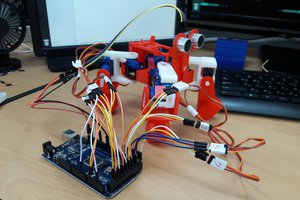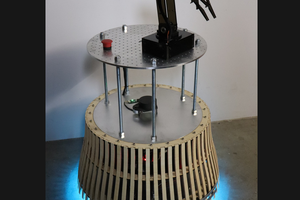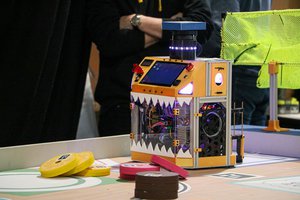PART 1
The optical encoder’s disc is made of glass or plastic with transparent and opaque areas. A light source and photodetector array read the optical pattern which results in a square wave signal. The rising and/or falling edge of the sensor square wave output can be used to count (each count is known as a ‘tick’) and estimate the distance traveled by a wheel. Incremental encoders can be hooked to the interrupt pins of the Arduino board to trigger every tick. Gyroscopes are sensors used to obtain the orientation of a body on a particular plane or in space. Yaw rate gyroscopes are sensors that give the rate of change of angular position of a body in a particular axis. Such sensors can be used to determine the angular position of a moving body. These two sensors can be used in conjunction to estimate the state of the robot.
Odometry is the use of data from moving sensors (wheel encoders) to estimate a change in position over time. Odometry is used by some robots, whether they are legged or wheeled, to estimate their position relative to a starting location. This method is sensitive to errors. Rapid and accurate data collection is required for odometry to be used effectively. Odometry can be implemented on a differential drive robot with two sets of wheel encoders on either shaft of the motor attached to a wheel.
Let the radius of the wheel be R.
Let y and z be the number of counts or ‘ticks’ from the encoder.
Let Nl and Nr be the counts or ‘ticks’ per each revolution of the wheel.
Dl = 2 × π × R × (y/Nl) (1)
Dr = 2 × π × R × (z/Nr) (2)
Dc = (Dl + Dr) / 2 (3)
Equation (1) and (2) represent the distance traveled by each wheel. Equation (3) represents the distance traveled by the robot.
Φ= (180 / π) × (Dl – Dr) / L (4)
Equation (4) represents the current angle of the differential drive robot, where L is the wheelbase (distance between the two wheels of the robot). Equations (1), (2), (3) & (4) are used to estimate the current position of the bot.
Xpos = Dc × (180/π) × sin(Φ) (5)
Ypos = Dc × (180/π) × cos(Φ) (6)
Equation (5) and (6) give the current position of the bot along the x-axis and y-axis. Hence these equations determine the position of the bot in the Cartesian coordinate form.
Having the current position and the orientation of the robot it is possible to control and navigate the robot through a series of coordinates. PID algorithm can be used to navigate the robot, where the control variable is the angle of the bot (Φ), the process variable is the desired angle (Φd) and the manipulated variable is given to the motors of the differential drive robot.
Φd = (180 / π) × arctan((Yg-Ypos) / (Xg-Xpos)) (7)
Equation (7) can be used to generate the desired angle of the robot. The desired angle is the formed by the line joining the current position...
Read more »


 Cassiano Campes
Cassiano Campes
 Will Donaldson
Will Donaldson
 Vladimir
Vladimir
 Gaultier Lecaillon
Gaultier Lecaillon
Cool! Do you think in use ROS to do a real time environment detection?